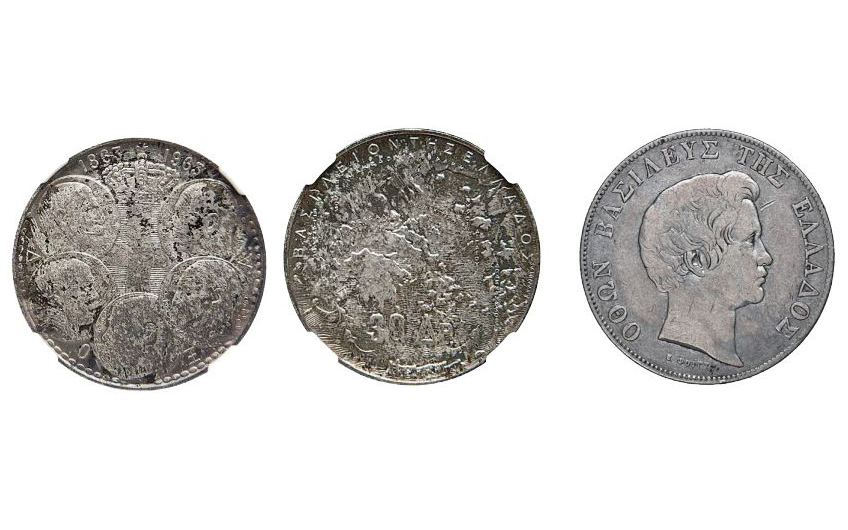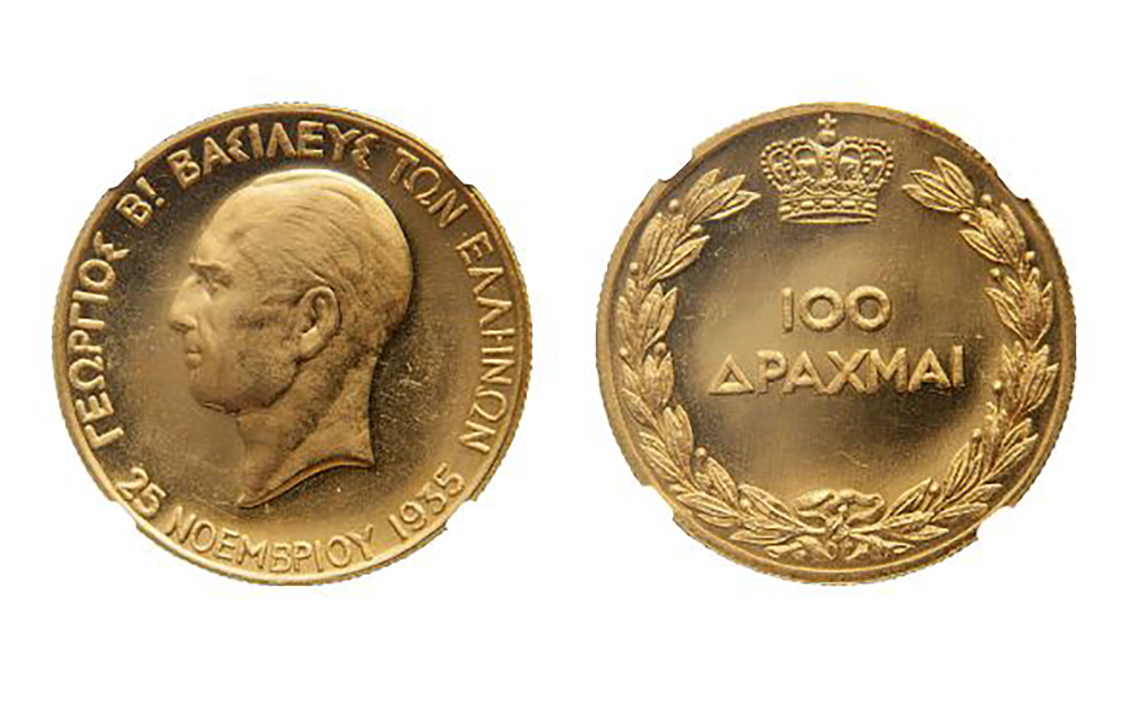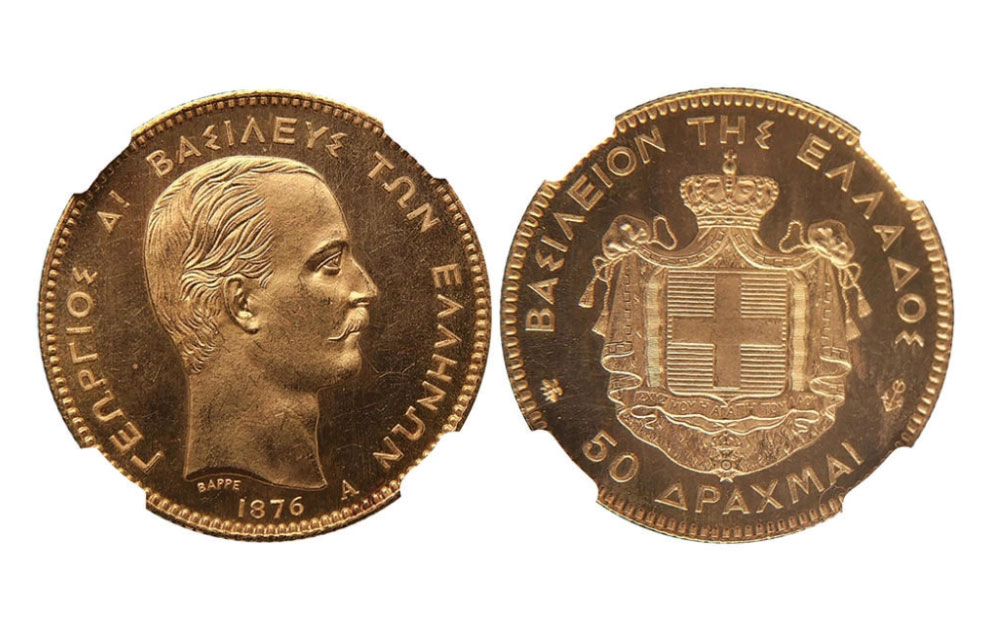King George I of Greece celebrated a decade on the throne in 1876 after the deposition of Otto. The Ionian Islands had been transferred to Greece, Harilaos Trikoupis had won the battle for introducing the vote of confidence in Parliament, and the 1866-69 Cretan revolt had been violently quashed.
The country was in dire economic straits, but, believing that it should not appear to be poor, the monarch ordered 182 gold 50-drachma coins and 76 100-drachma coins from foreign mints, designed to depict his portrait on one side – as was the custom – and the royal coat of arms on the other, flanked by a bee and an anchor.
“This must have been purely for propaganda reasons. I can’t imagine that anyone thought these coins would circulate in the market. They must have been given to George’s officers; I don’t believe they circulated more widely,” says Nikos Mathioudakis, the founder and chief executive of Attica Auctions, a new auction house that is getting ready to launch its online edition, while also providing evaluation and assessment services as of the new year.
It is these kinds of characteristics that make coins so valuable to collectors, while the better their condition, the higher the price they can fetch from collectors and investors – as evidenced by Attica Auctions’ most recent sale, held in Switzerland on November 17, in cooperation with Numismatica Ars Classica (NAC).
Greek collections were the highlight of the sale of coins from all around the world, with the 50-drachma coin closing at 140,000 Swiss francs (around 133,000 euros), or three times its starting price. “This specific 50-drachma coin from 1876 is the fourth most expensive Greek coin ever sold,” notes Mathioudakis. The first is a 100-drachma non-circulated coin from 1875, which went for 300,000 Swiss francs in 2014.

We met Mathioudakis in downtown Athens in the space that will soon open as Attica Auctions’ headquarters. Raised abroad and interested in coinage as only an avid collector can be, Mathioudakis gave up a PhD in molecular biology and genetics to pursue his passion, which launched a career with auctioneers Morton and Eden (formerly associated with Sotheby’s), Heritage Auctions and Kunker.
He recently decided to bring the know-how he acquired abroad to Greece, where, he believes, there is a critical mass of collectors and coins that could support the competition between two numismatic auction houses (the other being A. Karamitsos Auctions). “Collectorship runs in our blood. I estimate that there are between 5,000 and 10,000 collectors in Greece right now, with turnover ranging from 3-5 million euros a year,” he notes, adding that these numbers are much higher if you also include sales of gold sovereigns.
Among Greek coins, the historical periods that appear most coveted among collectors and investors are the reigns of Otto and George I. The royal mint during the former’s reign was at present-day Klafthmonos Square, just off Stadiou Street, and was equipped with presses from Munich, as well as older machines from the mint on the island of Aegina founded by Ioannis Kapodistrias. Those presses had been used by the Knights of Saint John of Malta in the 18th century and were purchased at a bargain price by Greece’s first governor, but their advanced age meant that the coins they produced tended to have flaws.
Certification
The coins minted during Kapodistrias’ time are mainly of value only to collectors, as they were almost all made of copper, with the exception of one minted in 1828 with the image of a phoenix that only came out in small numbers because of a shortage in silver. “Rarity is what makes something collectible. Collectors are not interested in a coin’s condition, but in its age or because it complements a collection. An investor, however, wants each coin to be in the best possible condition,” explains the auctioneer. As expected, coins that saw heavy usage in their time also tend to have the most damage, while those that have been stored and carefully protected increase in score and value. Mathioudakis explains that each coin is assigned a score according to an international grading standard and its price can skyrocket if it gets a high score, as was the case with the gold 50-drachma coin.

What is not visible to even the most experienced eye, however, is the stories told by each coin. For example, the 100-drachma gold coin minted by George II in 1935 to commemorate the fifth anniversary of the restoration of the monarchy – and one of the pieces at the November 17 auction – never made it to Greece. The Greek state had ordered 140 such pieces, but ultimately couldn’t pay the cost of producing them. Mathioudakis says they ended up at auctions at the time. The coin sold by Attica Auctions had a starting price of 15,000 Swiss francs and sold at 39,930 francs (38,000 euros).
Five monarchs
Another rare item is the 30-drachma coin released in 1963 by Paul I to commemorate the centennial of the Greek monarchy. It has the heads of the five kings on the one side and a map of Greece on the other. Three million of them were minted and many who own one believe they have something very rare. What brings the element of rarity into the picture, however, is that Paul asked that just 50 of these coins be engraved with the word “Αναμνηστικόν” (Commemorative) on the map side, so that he could gift them to important people. One of these commemorative coins fetched 7,865 Swiss francs (7,500 euros), up from a starting price of 5,000 francs, on November 17.
Mathioudakis says that the best sellers on the auction market right now are American coins, which can fetch as much as 10 million dollars, followed by British coins, which are particularly familiar to collectors as a result of the empire’s colonies. “These are coins everyone can understand. This is important to a collector,” he explains.
There are coin collectors in every country and their ranking follows that of the broader art market, which is led by China, followed by the US, the UK, Germany and Japan.
What is it that makes coins so attractive to collectors? On the one hand the prices in the numismatic market tend to be much lower than in the art market and are also on a steady increase. Furthermore, coins are small and therefore easy to transport and store. There is also the fact that every coin has a story, and since we’re talking about Greek ones, Mathioudakis notes that a collector can understand the conditions that prevailed in the country at any given time by the examining the material and condition of the coins minted then. “It is a miniature of history that is small enough to fit in a drawer,” he says.












